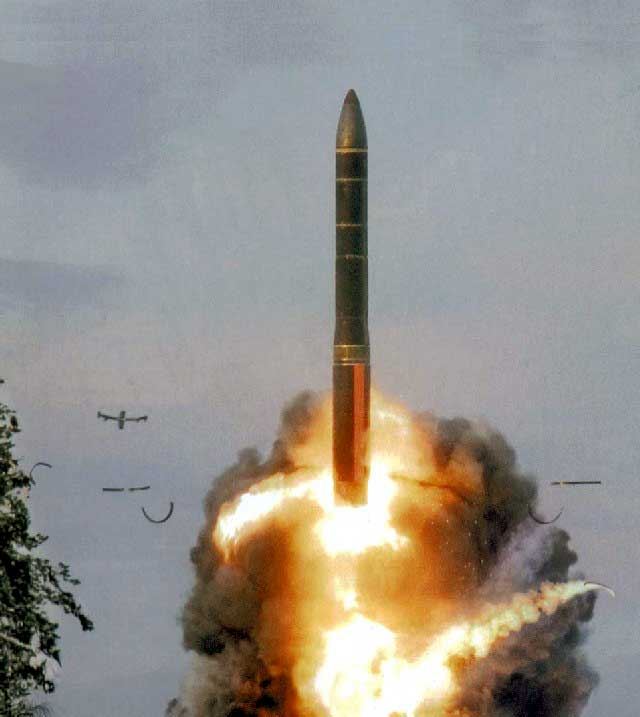Wednesday, May 19, 2010
New Russian Missile System a Tool for Terrorists?
A weapons system camouflaged as an ordinary shipping container poses a massive threat to ships up to 400 miles offshore.
Pajamas Media
Last month, weapons buyers and sellers gathered at the Putra World Trade Center in Kuala Lumpur, Malaysia, for what was promoted as “the biggest, most attended and most successful” weapons fair in the past twenty years.
One item garnered more attention that others. Among the assault rifles, armored vehicles, and fighter jets was a portable cruise missile system engineered to launch from a generic-looking shipping container.
This is “not good news,” a former intelligence officer told me.
Unlike traditional missile systems, the Club-K container missile system is not immediately recognizable as a weapons system. With camouflage as its primary feature, the Club-K seems to be a dangerous fit for rogue nations and terrorist groups.
A Russian defense contractor called Concern Morinformsystem-Agat developed the missile system. There is a marketing video on the company’s website which shows how the missiles can be launched, via satellite command, from where they are hidden inside what appears to be a shipping container. The roof of the container slides back, a missile launcher moves into the upright position, and one by one, all four missiles deploy.
In one scenario, the Club-K container is shown innocuously concealed among a group of legitimate containers bearing the logo of South Korean mega-shipper Hanjin. Club-K containers can be offloaded from unsuspecting cargo ships and transferred onto railroad cars or onto the flatbed of a truck.
Shortly after its unveiling in Malaysia, Club-K’s Russian weapons maker was accused of developing a system tailored for rogue nations. In its defense, the company issued a press release saying “not all the countries are able to afford such expensive ‘toys’ for their fleet as corvettes, frigates, destroyers, cruisers and other vigorous ships equipped with missile weapon.” And then, as if playing into the hands of critics, Concern Morinformsystem-Agat declared: “Nobody has the right to deprive [others] of the opportunity to have its power of sovereignty. Moreover the potential aggressor should keep in mind that he can suffer unacceptable damage.”
Adding a strange, Stanley Kubrick feel to the debate, the company website offers a video version of its press release … read by a pretty Russian model in a bright orange sweater in front of a white wall. Look closely: there’s a logo of Lenin and a hammer and sickle in the background.
There are other dangers to this portable missile system besides it falling into terrorists’ hands. The Telegraph reports that both Iran and Venezuela “have already shown an interest in the Club-K container missile system which could allow them to carry out preemptive strikes from behind an enemy’s missile defenses.”
Debkafile.com observes: “In Iranian hands it would make the targeting of its nuclear facilities very difficult. Able to wipe out an aircraft carrier up to 400 kilometers away, … Western military experts are calling it a ‘real maritime fear for anyone with a waterfront.’”
During the Cold War, the U.S. regularly moved missiles around the country on trucks, and around the globe inside bombers with the Strategic Air Command. The Soviet Union took similar defensive measures by moving their own ICBMs around on railroad cars. The logic behind portable missile systems is that a moving target is a lot harder to hit than a known, stationary one.
But the Cold War is supposedly over and this portable missile system now being marketed in Moscow presents an entirely new set of 21st century problems.
Most troubling is the fact that an advanced missile system such as this one could not be up for sale without the approval of the Kremlin, just as U.S. defense contractors like Raytheon and Lockheed can’t market weapons systems without approval from the Pentagon. In allowing the Club-K container missile system to be sold to anyone willing to pay the price (approximately $20 million in U.S. dollars), Moscow is opening up a new arms race in the Middle East.
Says Reuben Johnson, a consultant for the Pentagon: “This is ballistic missile proliferation on a scale we have not seen before, because now you cannot readily identify what’s being used as a launcher because it’s very carefully disguised.”
Annie Jacobsen writes about aviation and intelligence. She blogs at TheAviationNation.com and is working on a new book for Little Brown and Company.

